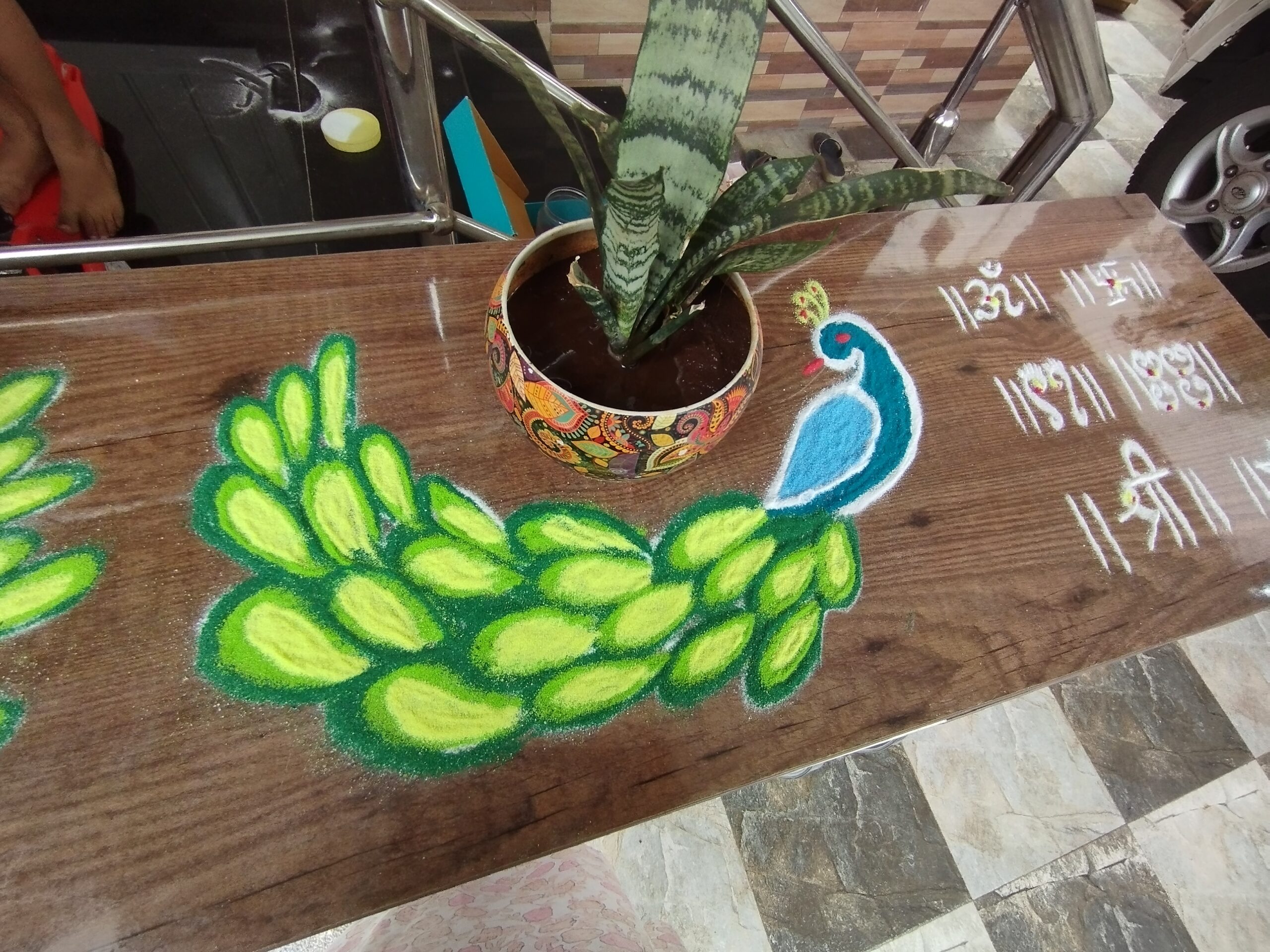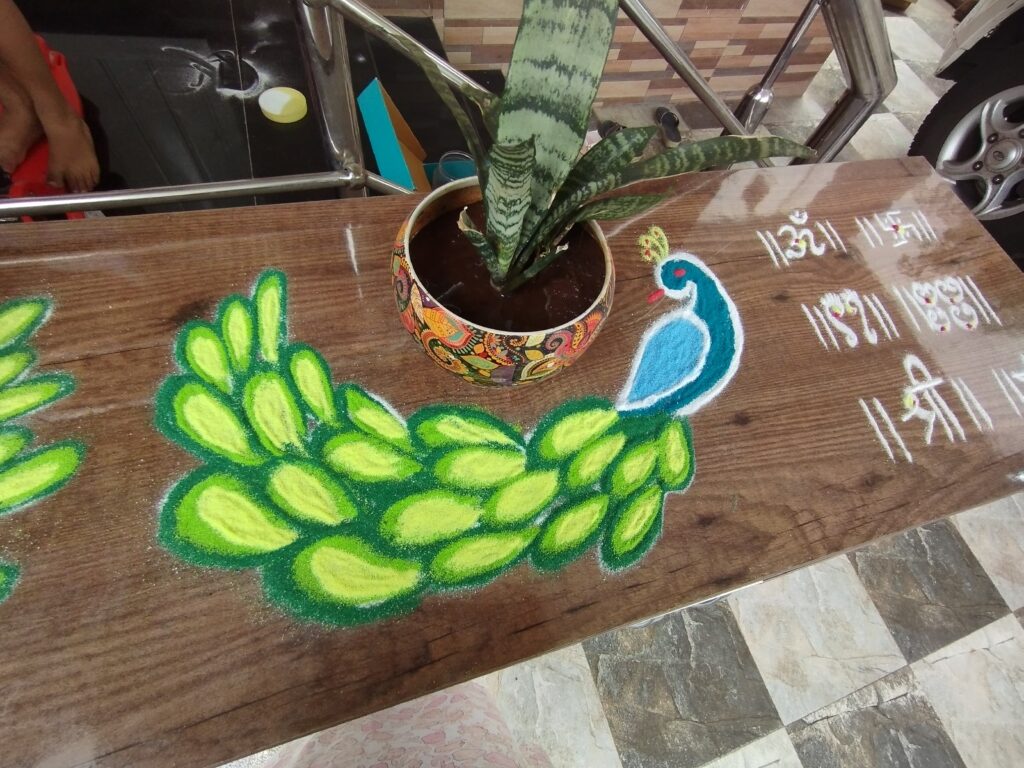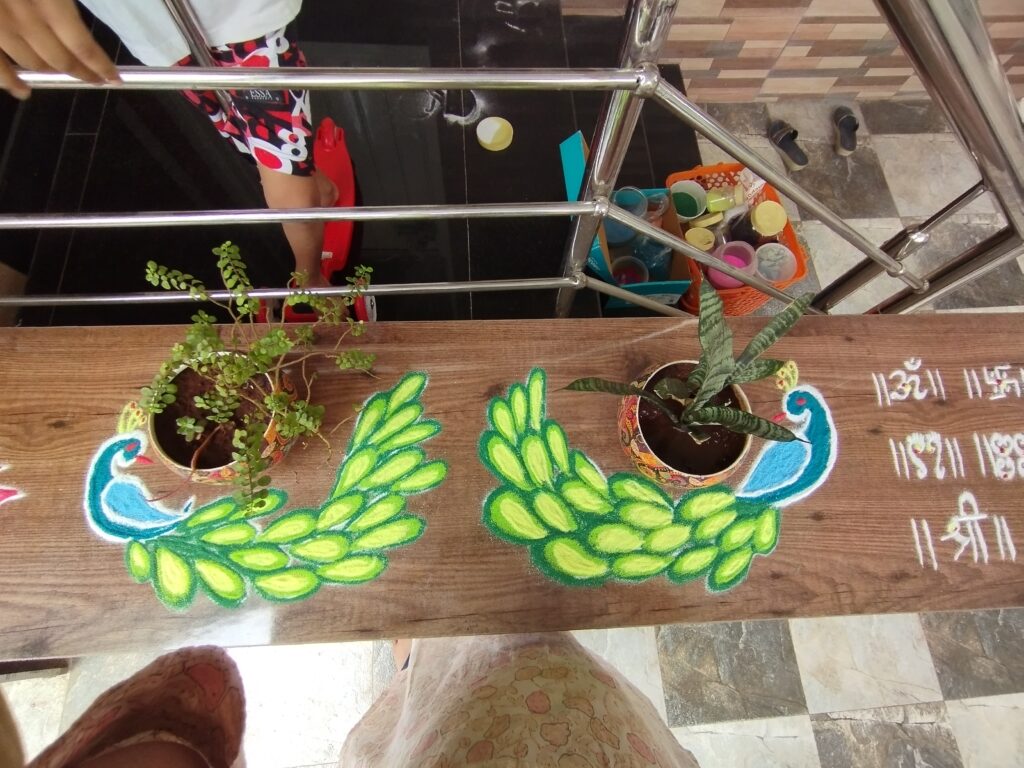Peacock rangoli- Rangoli around pot

Peacock rangoli is all time favorite.
Just need a good color combination.


Peacock rangoli designs are a captivating and popular form of traditional Indian art. These vibrant and intricate patterns inspired by the graceful peacock have been cherished for generations. In this article, we will explore the beauty of peacock rangoli and how to create a stunning peacock rangoli design specifically around a pot. By incorporating the SEO keyword “peacock rangoli,” we aim to provide valuable insights and step-by-step guidance to help you create a visually appealing rangoli design.
Understanding Peacock Rangoli:
Peacock rangoli designs are known for their colorful and symmetrical patterns that mimic the exquisite plumage of the peacock. These designs often feature a central peacock motif surrounded by intricate details, such as feathers, swirls, and floral elements. The peacock, considered a symbol of beauty, grace, and spirituality, holds significant cultural and religious importance in India.
Creating a Peacock Rangoli Around a Pot:
Step 1: Preparing the Base and Pot:
Choose a suitable location for your peacock rangoli design. Clean the area and ensure it is free of any dirt or debris. Place a pot at the center of the chosen space, as it will serve as the focal point for the rangoli. Ensure that the pot is clean and dry before proceeding.
Step 2: Outlining the Design:
Using a chalk or pencil, sketch the outline of the peacock and the surrounding elements around the pot. You can refer to peacock rangoli design templates available online or create your own unique design. Focus on creating a symmetrical pattern to maintain the visual balance of the rangoli.
Step 3: Coloring the Base:
Start by coloring the base area of the rangoli around the pot. Use vibrant colors such as blues, greens, and yellows to depict the peacock’s feathers. Blend the colors smoothly to create a gradient effect, starting with a lighter shade at the outer edges and gradually deepening the hues toward the center.
Step 4: Drawing the Peacock:
Begin by drawing the peacock’s body using contrasting colors like shades of blue or green. Add intricate details to depict the feathers using fine lines and curves. Use a variety of colors to highlight the details and create depth. The peacock’s head, beak, and eye can be drawn with precision and intricate patterns.
Step 5: Enhancing the Design:
Surround the peacock with complementary elements such as feathers, swirls, and flowers. These details can be filled with vibrant colors like shades of purple, pink, and orange. Add fine lines, dots, and small patterns to embellish the design and give it a more intricate and visually appealing look.
Step 6: Adding Finishing Touches:
Once the design is complete, carefully clean any excess powder or flour from the surroundings to achieve a polished and refined look. Consider placing diyas (oil lamps) or flower petals around the rangoli to enhance its overall appearance and create a warm and inviting ambiance.
Creating a peacock rangoli around a pot is a delightful way to showcase the beauty and artistry of traditional Indian culture. By incorporating vibrant colors, intricate patterns, and the majestic symbolism of the peacock, these rangoli designs exude elegance and grace. Follow the step-by-step guidance provided in this article to create your own stunning peacock rangoli design. Embrace your creativity and enjoy the process of crafting a mesmerizing peacock rangoli that will leave a lasting impression on all who admire it.

The peacock holds significant symbolism in Hindu religion and culture. Its vibrant plumage and graceful demeanor have made it an emblem of beauty, divinity, and spiritual significance. Here are some key aspects of the peacock’s significance in Hindu religion:
- Association with Hindu deities: The peacock is closely associated with Lord Krishna and Goddess Saraswati. In Hindu mythology, Lord Krishna is often depicted wearing a peacock feather in his crown, symbolizing his divine charm and grace. Goddess Saraswati, the Hindu goddess of knowledge, art, and music, is depicted sitting on a peacock, symbolizing wisdom, creativity, and vibrancy.
- Symbol of Lord Murugan: Lord Murugan, also known as Kartikeya or Skanda, is a popular deity in South India. He is considered the god of war, victory, and spiritual enlightenment. Lord Murugan is often depicted riding a peacock, emphasizing his connection with courage, beauty, and triumph over obstacles.
- Symbolism of Beauty and Immortality: The peacock’s stunning plumage is seen as a representation of beauty and grandeur. Its resplendent colors and distinctive feathers symbolize the diversity and vibrancy of life. In Hinduism, the peacock is also associated with immortality. It is believed that the peacock’s consumption of poisonous substances without any harm represents the ability to transmute negativity into positivity.
- Connection with Rain and Fertility: In Hindu folklore, the peacock is associated with rain and the arrival of the monsoon season. It is believed that the peacock’s dance and melodious call signify the arrival of rain, thus associating it with fertility and abundance. The peacock’s feathers are sometimes used in rituals and ceremonies to invoke blessings of prosperity and well-being.
- Significance in Indian Art and Culture: The peacock’s regal appearance and graceful movements have inspired artists and craftsmen throughout history. Its representation can be found in various forms of Indian art, including paintings, sculptures, textiles, and rangoli designs. The peacock motif is often incorporated in architectural elements of temples, symbolizing divinity and spiritual enlightenment.
- Symbol of Protection: The peacock is believed to possess protective qualities and is considered a guardian against evil spirits and negative energies. It is common to find peacock feathers placed in homes, vehicles, and other sacred spaces to ward off negative influences and bring good fortune.
The peacock holds a significant place in Hindu religion and culture. Its association with deities, symbolism of beauty and divinity, connection with rain and fertility, and protective qualities make it a revered and cherished creature. The peacock’s presence in Hindu mythology and its influence in various aspects of Indian art and spirituality further emphasize its significance in the Hindu religious tradition.

